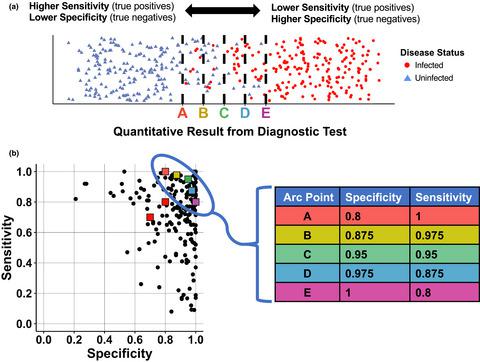当前位置:
X-MOL 学术
›
Ecol. Evol.
›
论文详情
Our official English website, www.x-mol.net, welcomes your
feedback! (Note: you will need to create a separate account there.)
Estimating prevalence and test accuracy in disease ecology: How Bayesian latent class analysis can boost or bias imperfect test results.
Ecology and Evolution ( IF 2.3 ) Pub Date : 2020-06-15 , DOI: 10.1002/ece3.6448 Sarah K Helman 1 , Riley O Mummah 1 , Katelyn M Gostic 1 , Michael G Buhnerkempe 1, 2 , Katherine C Prager 1, 3 , James O Lloyd-Smith 1, 3
中文翻译:

估计疾病生态学中的患病率和测试准确性:贝叶斯潜在类别分析如何提高或偏差不完美的测试结果。
更新日期:2020-07-30
Ecology and Evolution ( IF 2.3 ) Pub Date : 2020-06-15 , DOI: 10.1002/ece3.6448 Sarah K Helman 1 , Riley O Mummah 1 , Katelyn M Gostic 1 , Michael G Buhnerkempe 1, 2 , Katherine C Prager 1, 3 , James O Lloyd-Smith 1, 3
Affiliation

|
- Obtaining accurate estimates of disease prevalence is crucial for the monitoring and management of wildlife populations but can be difficult if different diagnostic tests yield conflicting results and if the accuracy of each diagnostic test is unknown. Bayesian latent class analysis (BLCA) modeling offers a potential solution, providing estimates of prevalence levels and diagnostic test accuracy under the realistic assumption that no diagnostic test is perfect.
- In typical applications of this approach, the specificity of one test is fixed at or close to 100%, allowing the model to simultaneously estimate the sensitivity and specificity of all other tests, in addition to infection prevalence. In wildlife systems, a test with near‐perfect specificity is not always available, so we simulated data to investigate how decreasing this fixed specificity value affects the accuracy of model estimates.
- We used simulations to explore how the trade‐off between diagnostic test specificity and sensitivity impacts prevalence estimates and found that directional biases depend on pathogen prevalence. Both the precision and accuracy of results depend on the sample size, the diagnostic tests used, and the true infection prevalence, so these factors should be considered when applying BLCA to estimate disease prevalence and diagnostic test accuracy in wildlife systems. A wildlife disease case study, focusing on leptospirosis in California sea lions, demonstrated the potential for Bayesian latent class methods to provide reliable estimates under real‐world conditions.
- We delineate conditions under which BLCA improves upon the results from a single diagnostic across a range of prevalence levels and sample sizes, demonstrating when this method is preferable for disease ecologists working in a wide variety of pathogen systems.
中文翻译:

估计疾病生态学中的患病率和测试准确性:贝叶斯潜在类别分析如何提高或偏差不完美的测试结果。
获得疾病流行率的准确估计对于野生动物种群的监测和管理至关重要,但如果不同的诊断测试产生相互矛盾的结果并且每个诊断测试的准确性未知,则可能会很困难。贝叶斯潜在类别分析 (BLCA) 建模提供了一种潜在的解决方案,在没有诊断测试是完美的现实假设下提供患病率水平和诊断测试准确性的估计。
在这种方法的典型应用中,一项测试的特异性固定为或接近 100%,使得模型除了感染流行率之外还可以同时估计所有其他测试的敏感性和特异性。在野生动物系统中,具有近乎完美特异性的测试并不总是可用,因此我们模拟数据来研究降低这种固定特异性值如何影响模型估计的准确性。
我们使用模拟来探索诊断测试特异性和敏感性之间的权衡如何影响患病率估计,并发现方向偏差取决于病原体患病率。结果的精确度和准确性都取决于样本量、所使用的诊断测试以及真实的感染流行率,因此在应用 BLCA 估计野生动物系统中的疾病流行率和诊断测试准确性时应考虑这些因素。一项野生动物疾病案例研究,重点关注加利福尼亚海狮的钩端螺旋体病,证明了贝叶斯潜在类方法在现实条件下提供可靠估计的潜力。
我们描述了 BLCA 在各种流行水平和样本量范围内改进单一诊断结果的条件,证明了这种方法何时更适合在各种病原体系统中工作的疾病生态学家。











































 京公网安备 11010802027423号
京公网安备 11010802027423号